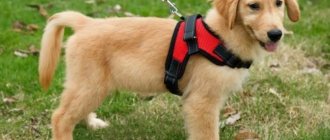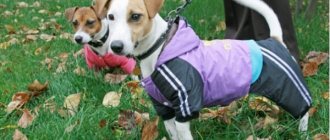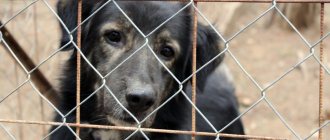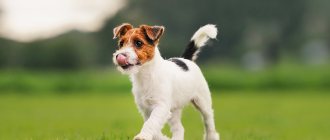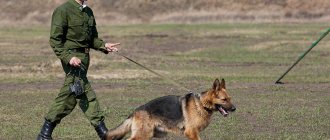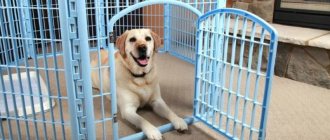A harness, being an alternative to a collar, creates comfortable conditions for the dog, transferring the load from the animal’s neck to the shoulder and chest areas.
Saddlery leather is ideal for making harnesses, since the material from which the harness is made should not be too soft. Otherwise, after some time, the tension will cause the straps to curl into a tube and begin to cut into the dog’s skin and rub. The belts should be wide, dense and sufficiently rigid. Only under this condition will they keep their shape well, and, therefore, the harness will fit well and will serve you for many years.
It is important that the harness is perfectly adjusted in size and takes into account the temperament and physical strength of the dog. The harness should fit the dog's body tightly enough, the straps should not sag, but they should not squeeze too much and restrict movement. When positioned correctly, the palm of an adult can fit freely between the harness and the animal’s body.
To determine the size of the harness, you need to measure the circumference of the chest at the widest point behind the front legs and add 2 cm for the loose fit.
Harness selection table
CHEST CIRCUMSTANCE (cm)
HARNESSES FOR SMALL AND MEDIUM BREEDS OF DOG
Chihuahua, Miniature Poodle, Phalene, Miniature Pinscher, Yorkshire Terrier, Russian Toy Terrier similar
Chihuahua, Miniature Poodle, Phalene, Miniature Pinscher, Yorkshire Terrier, Russian Toy Terrier, Griffons and the like
English cocker spaniel, German spaniel, Russian spaniel, griffins, field, hound, etc.
French bulldog, pug, beagle, border collie, dachshund, miniature schnauzer, bull terrier, fox terrier, Jack Russell terrier, other medium-sized terriers, etc.
Airedale Terrier, Husky, Laika, Pitbull, Boxer, Labrador, Retriever, Dalmatian, Doberman, Staff, etc.
chow-chow, collie, shiba inu, setter, husky, etc.
ROUND harness “CHOW”
HARNESSES FOR MEDIUM AND LARGE DOG BREEDS
German Shepherd, Husky, Laika, Doberman, Airedale Terrier, Labrador, Staff, Rottweiler, Giant Schnauzer, etc.
Malamute, Labrador, Rottweiler, Central Asian, Caucasian and other large shepherd dogs, Great Dane, Bloodhound, etc.
Pit Bull Terrier, American Staffordshire Terrier, Staffordshire Bull Terrier, English Bull Terrier, etc.
German Shepherd, East European Shepherd, Malinois, etc.
Central Asian Shepherd Dog, Caucasian Shepherd Dog, etc.
Nowadays, dog harnesses are becoming a popular accessory that replaces the classic collar. Each of the products designed for walking a pet has its own pros and cons. Therefore, it is worth understanding what a harness is, how to choose the right size for your pet, and what is the main advantage of a harness over a collar?
What to consider when choosing
Harnesses can be used for various purposes: for regular walks, sports activities or official work. In winter, they can also be used traditionally - to harness a dog to a sled and transport loads with it. Such events can be turned into an interesting game - a pet pushing a child on a sleigh will get the physical exercise he needs and give the family a lot of positive emotions. To know how to choose the right harness for your dog, focus on the following indicators:
- Material. Manufacturers use durable, soft and wear-resistant materials. At the same time, not all companies treat their work responsibly. Please note that during walks a lot of dirt will appear, so the harness should be easy to wash. It is best to make a choice with a minimum amount of knowledge about all the available varieties. For dogs of miniature breeds, light woven products are suitable, while for a wolfhound the best solution would be a heavy leather harness;
- Zas
What is a harness, its types
Special equipment for dogs, which gradually replaces the collar, is usually called a harness. Its difference is that it is attached not to the neck, but to the body of the animal. Most often it is made of leather or strong material in the form of belts that encircle the chest and body of the dog, connecting between the front legs along the ridge.
Experienced dog breeders claim that this equipment is more practical and safe for the pet, since when the leash is sharply pulled, the animal does not experience pain in the neck, which is fraught with wearing a collar. You can see what the harness looks like in the photo below.
The classification of harnesses is impressive; their main difference is what purpose the equipment will serve and the size of the pet itself.
Let's look at the types of harnesses:
- Riding harnesses for dogs. Most often they can be found on pets that participate in sports competitions, in particular during sled dog racing. The towing type of this harness requires increased strength of the belts. The preferred material is nylon or canvas. The harness is perfect for malamutes and huskies.
- Harness with weights . They are used to strengthen the dog’s muscle mass, and are especially useful in case of broken paws in the animal. Special pockets on the straps allow you to regulate your pet's physical activity. Using this type of harness requires monitoring the dog's training, in particular jumping should be avoided. As an alternative, it is permissible to use a collar with a load, most often small. Its use is necessary to prepare a young pet for more serious weights. A collar with weights is suitable for large and medium-sized dog breeds (for example, Jack Russell Terrier); for small breeds it is better to avoid such equipment, as it can injure the pet’s cervical region.
- Harness-vest . An original accessory for a pet with short fur, which will help to further insulate it. Ideal for small pets that do not want strain on their necks, such as Pomeranians or Chihuahuas. Additionally, this type is used for medical purposes; the better structure of the equipment covers most of the dog’s body, and the attachment located near the hind legs allows the load to be transferred to the forelimbs.
- Walking harness. Most often it is made of thin material, such as leather or nylon. Constant use assumes that such a collar for dogs through the paws will “fit according to the figure” and will not interfere with the animal in any way.
- Guardhouse . The most durable option of all. Usually these are two-layer or more harnesses, with stitched straps and welded rings, with the help of which the dog is tied to the checkpoint. Strong material will not allow the animal to fall off.
- Harness for puppies. Lightweight and soft option that reduces the load on the spine. You should start dressing after six months of age, when the animal’s skeleton is fully formed and the muscles are sufficiently strengthened. Remember that an untimely harness can significantly damage the health of your little pet.
Which harness to choose
This question is often asked by dog owners who have decided to stop using a collar and switch to this type of equipment. Dog handlers recommend giving preference to a harness that:
- Made from quality materials. It can be nylon, canvas or leather. It should be easy to wash and dry quickly. If your pet gets dirty outside, this product can be washed and dried quickly. Consequently, the dog will again be able to go out for the next walk in its usual equipment;
- Fastening elements must be strong and not cause inconvenience during movement. It is important to pay attention to their location. Rings, carabiners and other fasteners should not rub or cause discomfort;
- Perfect fit. A model that is too tight will rub when moving and can lead to the formation of bald spots. And if it is too loose, it will not securely hold the dog in place.
This is important: when choosing a model for medium or large dogs, you should give preference to reliable metal fittings. But for miniature decorative pets, plastic clamps and fasteners will be enough.
Harness or collar for a dog: which is better?
Dog handlers argue a lot about this; on the one hand, a collar is better suited for training, but on the other, the risk of damaging the neck with it is significantly higher. Therefore, in your choice, be guided, first of all, by the size of the pet.
So for small breeds, a harness is a good option, as it relieves the load on the cervical region, which is inevitable from a collar. Made of soft material and beautiful harnesses, they will not cause any harm to the animal’s fur, and at any pet store you can buy a harness of the size you need. If the owner has a question about how to properly put a harness on a pet’s body, you can find out about this in a separate article.
In addition, keep in mind that, for example, for a pug with its flattened muzzle and head circumference smaller than the neck circumference, wearing collars is simply contraindicated. This is a problematic breed in terms of wearing a collar, as it will either fall off or significantly injure the animal .
The right harness makes breathing easier for breeds such as the Pekingese, Bulldog and Yorkshire Terrier.
It is also acceptable to use harnesses for large breeds. Most often this is associated with sports activities, such as towing a skier or simply developing muscles. In this case, various types of harnesses made of high-strength material and cargo harnesses will simplify this task for you, since they are created by experienced dog handlers in cooperation with veterinarians.
Experts say that the use of a collar, especially with frequent and sharp tugging, not only creates the precondition for injury to the pet, but also increases its aggressiveness.
This occurs due to the fact that the animal's airways are blocked. To avoid this, use a harness. Its design allows the dog to feel more comfortable, which will significantly simplify control over the pet.
About puppy harnesses
If we talk about the best options for a puppy, then the opinion here is clear, since a harness can only be used after 6 months of life. This should be a convenient and good option that will not put stress on the fragile spine.
What to consider when choosing
The main requirement for the product is convenience for daily use, but the owner must take into account that it should not be used daily. The harness is considered as a tool for training and special physical training of the pet, but too frequent use can damage the coat. After a walk or completing a required task, it is better to remove it; leaving the dog in a harness at home unattended is unacceptable, as this can lead to undesirable consequences.
How to choose the right size harness for a dog?
Having become familiar with the types of harnesses and their main advantages, you should move on to how to choose the right equipment based on the size of your pet.
But before that, we list the main properties that a quality product should have:
- easy to wash, soft material;
- all fasteners must fit tightly to the belts and not create inconvenience when putting on or wearing;
- leather belts with the ability to adjust the size;
To determine the optimal size of harnesses for each specific pet, you need to take the following measurements:
- Neck, where the collar is located.
- Bust circumference is measured at the widest point, adding 2 cm to the result.
- The back is from the withers to the beginning of the tail.
Usually, places where harnesses are sold have a special table with dimensions, based on which you can choose the right equipment for your dog. Keep in mind, if your animal does not fall into a certain size, then it is better to get a growth harness than a small one. The picture shows a detailed diagram of which areas need to be measured and where.
I also recommend taking a look at this video:
Harness for large breed dogs
Features of choosing a harness for large breeds depend, first of all, on the purpose for which they are purchased. For watchdogs, the main characteristic will be the durability and comfort of the equipment; for sled dogs, it will be a perfectly fitted accessory that will not dangle and distract while running.
Please note that the traction harness requires special measurements, which are related to the specific design.
The sled dog needs to be measured:
- chest length;
- distance from the beginning of the chest to the withers;
- the length of the segment from the end of the chest to the beginning of the tail;
Remember that the ideal accessory should neither squeeze the dog’s body nor dangle. A human palm should fit under the harness. The approximate price for different sizes of harnesses for large breed dogs will be slightly higher, due to the fact that more material is required to make them.
A riding harness for large dogs with sizes XL will cost from 1,700 rubles, and a harness-vest will cost from 4,000 rubles. You can buy them in an online store for dogs, where you can always find a wide selection of similar accessories.
Harness for medium breed dogs
If your pet falls under sizes M and L, then prices for riding harnesses for it will range from 1200 to 1500 rubles, and vests from 2200 to 3000 rubles. The cost will largely be determined by the material from which the accessory will be made.
Tips and tricks
Device for the pet's comfort
All the owner's attention should be focused on how the dog feels in the harness. The equipment, like the suit, should fit well on the figure.
You must put the harness on your pet very carefully so as not to scare him. It is best to distract him with a toy, and after the procedure is completed, treat him with a treat.
For reference! Quality products are produced by such companies as Perfect Fit, Ruffwear, Zero DC Short Harness, Haqihana, Niggeloh Follow, Ferplast.
The most important thing is the dog’s comfort. She should be comfortable wearing a harness and walking in it. This remedy will relieve animals from problems with the spine and neck that arise due to tight and heavy collars.
Choosing the size of a riding and universal harness
To determine the size of the riding harness, you need to measure the dog according to the AB indicator in the places indicated in the figure and compare it with the sizes in the table. The dog should stand as shown in the photo.
Find a bone (keel) on the dog’s chest; it sticks out and can be easily felt. From it (point A) measure the distance to the withers (point B). Take measurements only on one side (not the circle)!
The measurement should be done with a tailor's meter or tape, which can then be measured using a ruler. Be sure to measure tightly over the dog's body, squeezing the fur.
| AB | Size |
| 24 — 28 | XS |
| 29 — 32 | S |
| 33 — 36 | M |
| 37 — 40 | L |
| 41 — 44 | XL |
If your dog does not fit any of the standard sizes, you probably need a custom-tailored harness. Call us to resolve this issue.
For large breeds
The harness for oversized large dogs is designed to work with heavy loads. Usually they try to choose a wide leather model that can withstand the significant weight of the animal, multiplied by the speed of its jerk.
Important! Departmental nurseries often use sets with molded buckles - a large animal at the peak of activity can loosen a simple harness or bend a thin ring, from which the belt or leash will immediately fall off. Such a device costs more, but it also has a much greater resource.
For ease of walking, these devices come complete with structures that allow you to hold the leash freely and not tightly. Most often this is a carabiner or a brace connected to a ring located on top of a strip running across the back.
Convenient, especially if the dog is relatively calm and not prone to aggression. But for walks with representatives of fighting or service breeds, such a product is unlikely to be suitable.
For small breeds
Dwarf dachshunds, Spitz dogs and animals of similar size are the “clientele” of mini-harnesses.
In appearance, they are the same as devices for large dogs, only adjusted for size. There are perhaps more materials and colors in this segment than in any other.
Having put such a kit on your mini-dog, you can be sure that he will not go anywhere. In addition to the traditional leash and fastenings, these sets are often equipped with handles firmly sewn to the back strap. That is, an animal that has become excited can simply be picked up and carried away from a dangerous place.
For puppies
The youngest individuals require a special approach. The bone structure of babies is not yet formed, and a regular harness can disrupt the development of paws and muscles (especially in the sternum area).
Did you know? Dogs detect sounds with a frequency of up to 35 kHz, and the human ear works with ranges up to 20.
To avoid such difficulties, puppy kits are used from 6-9 months. The exact figure depends on the breed, so it is worth consulting with your veterinarian.
These sets stand out right away - the strips are narrower, and their leather or nylon base is well lined with soft material (so that the “harness” does not dig into sensitive skin).
For exhibitions
Here it is important to consider not only functionality, but also design.
The decoration and fittings should emphasize the color and noble character of its wearer. This also applies to the color scheme.
Much depends on the owner. The fact is that in pursuit of show endurance, sometimes they resort to trickery, putting a deliberately uncomfortable set on the dog (believing that by taking a size smaller, it will be possible to control its behavior unnoticed by visitors). The result is microtrauma and stress, plus the risk of not qualifying for the next examinations.
Find out what grooming is, how to make a pattern for a dog's overalls, how to choose a clipper and a furminator for your pet.
The other extreme is comfortable, but too bright LED-type harnesses. The flickering lights will only irritate the dog, and he will most likely try to get rid of the source of discomfort.
Freight
Used for training four-legged athletes.
There are two types:
- Half-vests with side pockets in which cargo is placed (rounded stones or bags of sand).
- Standard products with an additional belt, on the edge of which there is a ring with a chain that covers the weighting material. Usually this role is played by a car tire.
The main task is to develop the main muscle groups. In order for the classes to bring only benefits, you will have to control their progress. Jumping and too sudden jerking while wearing a weight harness are contraindicated. Important! During training, make sure that the “weight” in the pockets does not scratch or clog the client’s side. It is better to put sharp or too heavy objects aside.
Vests
Ideal for winter walks for pets with short hair or fine lines.
It is preferable to take products with a fur lining of small thickness - after running around in a vest that is too thick, the dog may catch a cold.
For sledding breeds
A sled harness is only suitable for a hardy and “diversified” dog - a Malamute, Husky or Samoyed.
The design combines strength and comfort for the dog himself. It is sometimes difficult to select such a product, so the way out of the situation is by ordering such kits from craftsmen.
This entails some costs, but such custom tailoring for dogs takes into account all the characteristics of an individual animal. The materials used are durable and moisture-resistant nylon or canvas.
The device itself is also different - there are more belts, as well as fastening rings (which allows you to evenly distribute the load on the body).
Choosing the size of the adjustable collar
To determine the size of an adjustable collar, half-choke, you need to measure the full circumference of the dog’s neck in the place indicated in the figure. The measurement should be done with a tailor's meter or tape, which can then be measured using a ruler. Be sure to measure tightly across the body, squeezing the wool.
Select the size from the range in which the largest margin is larger and smaller relative to what you got. This will allow you to avoid problems with adjusting the collar during natural fluctuations in the volume of the neck (for example, shedding).
| Neck circumference | Collar size |
| 19-27 | XXS |
| 25-35 | XS |
| 32-45 | S |
| 42-60 | M |
| 58-78 | L |
Recommendations for choosing a collar
Experts recommend choosing equipment for your pet only after having the opportunity to try it on.
Experienced dog handlers have various types of equipment at their disposal - for everyday walks, exhibitions, training and other events. They also advise other dog owners to do the same. Any equipment requires regular care - washing, cleaning, which will increase its service life and protect your pet from infection. Price is far from the most important criterion, since in pursuit of profit you can harm your four-legged friend. The pursuit of beauty is also inappropriate - rhinestones, rivets and other decorations can cause discomfort in the animal.
To make it easier to determine the size, you can focus on the standard - two fingers should fit freely between the animal’s neck and the product. To protect the animal's fur, it is better to choose ammunition with protective valves.
The choice of collar is made based on the breed:
- For those with a hard coat, it is better to choose collars that have a leather inner surface, a circular cross-section and external seams.
- Large, active dogs with a violent temperament are best bred with a strict collar.
- For pets with long, silky hair, a chain collar made of chromed metal is more suitable.
- To protect an overly curious and disobedient pet during the educational process, it is recommended to use a choke collar.
- For puppies, lightweight leather or fabric collars are suitable, equipped with a valve that protects the skin and fur from contact with metal parts.
Shoe size chart
If the attitude towards your pet’s clothing is ambiguous, even more so, questions arise: why are shoes needed? What is this? Glamorous entertainment for eccentric owners? Protecting pampered pets from dirt and cold? Nature has provided dog paws with adaptations to withstand adverse environmental conditions. Only man has changed the environment itself. In winter, city streets are treated with deicing agents - chemically aggressive substances that corrode the skin of dog paws. Shoes will protect your pet from cuts and bruises even in good weather.
How to choose a harness for a dog and choose the size
The second reason “in favor” is the reluctance to drag dirt into the apartment. Owners have a choice: wash their paws in a basin after every walk, purchase a paw washer, or train their pet to wear shoes.
